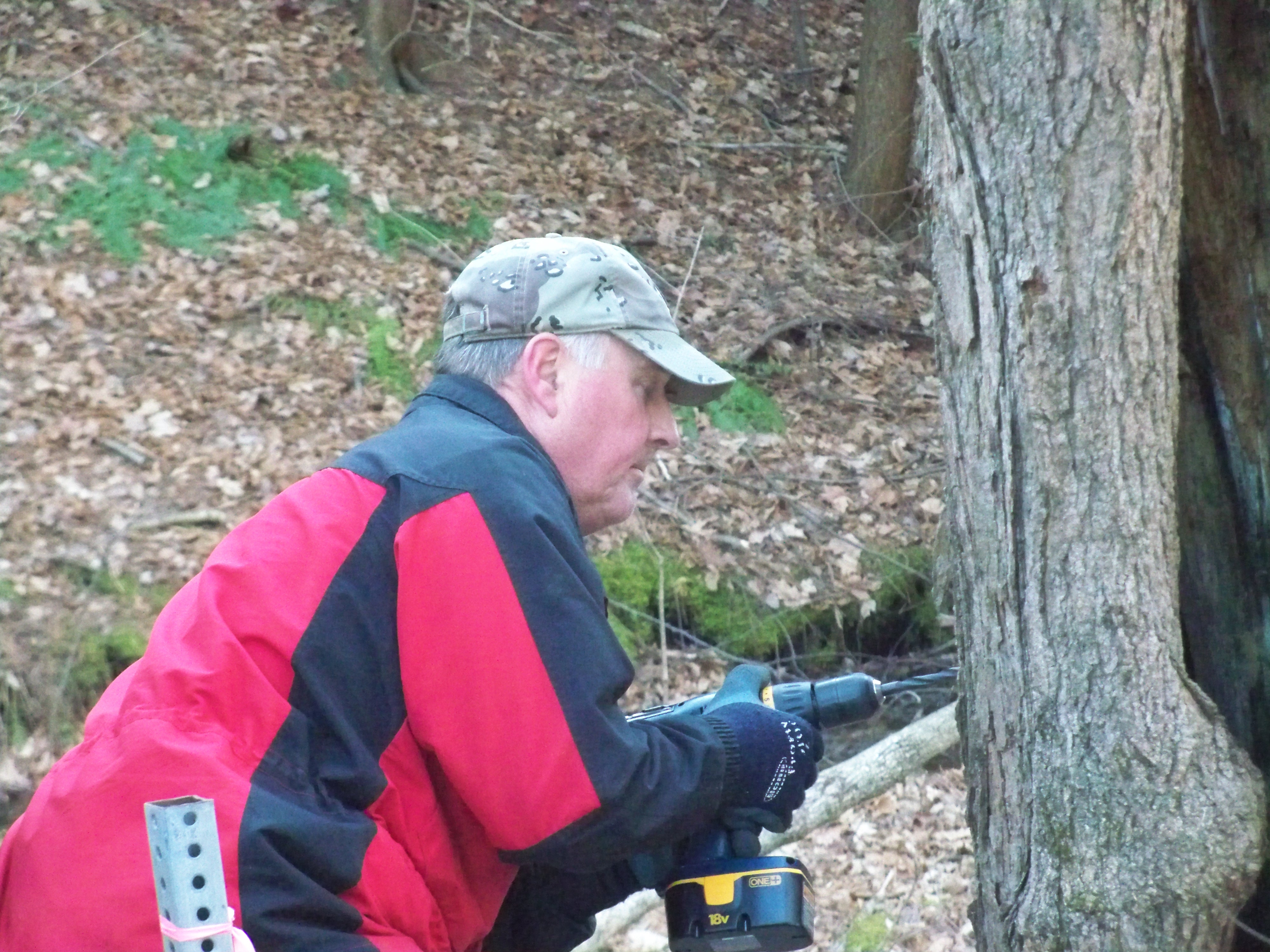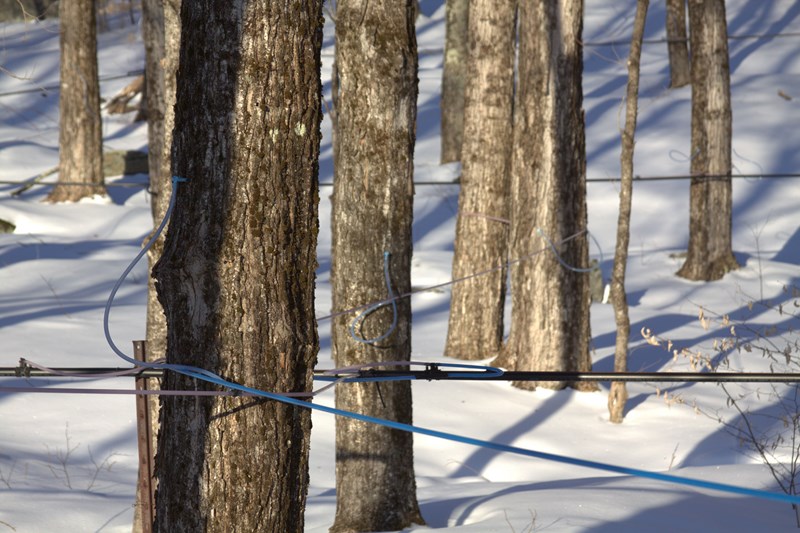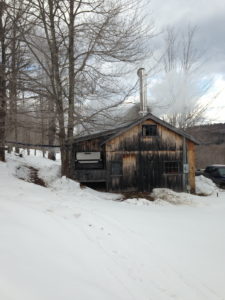How Maple Syrup is Made
How Maple Syrup is Made
Pure maple syrup is made by concentrating the slightly sweet sap of the sugar maple tree. The basics needed for making maple syrup therefore are some sugar maple trees and a method of concentrating the sap into syrup. As winter comes to an end, usually in late February or early March, sugarmakers prepare for their annual harvest of the maple trees. The group of maple trees that is used is called a sugarbush, or maple orchard. The sugarmaker prepares his or her sugarbush by clearing access roads in the snow, removing fallen branches, and setting up buckets or sap tubing systems. Whether they use tubing or buckets, sugarmakers must be sure that all their sap gathering, collecting, evaporating, and bottling equipment is absolutely clean and in good condition before the beginning of the season.
The beginning of the season
There is no set time when a sugarmaker must tap the trees. They must be aware of the clues of nature to tell when the time is right.
- Temperatures are not as extreme as earlier in the winter.
- Streams run with melting snow and icicles drip faster.
- Crows can be heard announcing the not-too-distant arrival of spring.
Mostly what the sugarmaker is waiting for is the arrival of the time of year known as “sugar weather,” when the nights are below freezing and the days are mild. This is the type of weather that makes the sap flow.
 When the sugarmaker feels the time is “right” they will start to tap trees. Tapping involves going from tree to tree in the sugarbush, drilling holes into the wood which carries the sap. If buckets are used to collect the sap, a metal spout or “spile” is tapped snugly into the hole, and a bucket is hung from a hook on the spout. A cover is put on the bucket to keep out rain, snow, and debris. If a plastic tubing system is used to collect the sap, a plastic spout, which is connected to the pipeline system, is tapped into the hole in the tree.
When the sugarmaker feels the time is “right” they will start to tap trees. Tapping involves going from tree to tree in the sugarbush, drilling holes into the wood which carries the sap. If buckets are used to collect the sap, a metal spout or “spile” is tapped snugly into the hole, and a bucket is hung from a hook on the spout. A cover is put on the bucket to keep out rain, snow, and debris. If a plastic tubing system is used to collect the sap, a plastic spout, which is connected to the pipeline system, is tapped into the hole in the tree.
The maple tree must be a least 10 inches in diameter and in good health before it can be tapped. It usually takes about forty years before a tree will reach tappable size. The hole is usually placed about waist high on the tree, and not near previous tapholes. Larger trees may take as many as three or four taps, but only if they are healthy. The sugarmaker has a feeling of respect for his trees and knows they must take care of this tree which provides for them. Trees that are in poor health or have been defoliated by insects are often tapped less, or not tapped at all. If proper tapping procedures are followed, tapping will not endanger the health and vitality of the tree. A healthy sugar maple can provide sap every year for a hundred years or more.
sap yield
Throughout the 4–6 week sugar season, each tap hole will yield approximately ten gallons of sap. This is only a small portion of the tree’s total sap production and will not hurt the tree. The average amount of syrup that can be made from this ten gallons of sap is about one quart. These amounts vary greatly from year to year, and depend upon the length of the season, the sweetness of the sap, and many complex conditions of nature, such as weather conditions, soil, tree genetics, and tree health.
sap flow is governed by the weather
When the trees have been tapped and all the equipment is ready, the sugarmaker is ready for the “first run,” that exciting time of the year when the sap first starts to flow, sap flow requires freezing nights and warm (but not hot) days. These must alternate and be in long enough series to allow the sap to move in the trees. For the first time each season the sap will drip into a bucket or slowly start to flow down the tubing system towards a collection tank. Prolonged periods of either below freezing temperatures or days without freezing nights will stop the sap flow. As a result, sugarhouses often start and stop boiling at different times due to local climatological factors. The gentle geographic progression is a reverse of the fall foliage season. That is, the lower elevations and more southern regions of Massachusetts usually start their maple seasons before the higher elevations and more northerly areas. Prolonged warm spells or cold snaps during the season may halt sap flow for several days, and it may start again when conditions are favorable. As a result, 24-hour work days are often interspersed with two, three or even more days of relative inactivity. This gives the sugarmaker a chance to recover lost sleep, make repairs, clean equipment, and get ready for the next sap “run.”
sugar content
 Maple sap, as it comes from the tree is a clear, slightly sweet liquid.
Maple sap, as it comes from the tree is a clear, slightly sweet liquid.
- The sugar content ranges from one to four percent.
- A device called a “hydrometer” can be floated in the sap to determine the exact sugar content.
- Sweeter sap is favored because less water will have to be evaporated to make maple syrup.
- The sap must be evaporated as soon as possible because the freshest sap makes the best quality syrup.
Where the bucket collection method is used, a sap gathering tank is mounted on a sled, wagon, or truck, and is moved through the sugarbush as the sap is gathered. Tractors are most often used, but sometimes teams of horses or even oxen pull the sleds or wagons.
- The sap is collected from each tree by workers using large gathering pails.
- These pails are dumped into the gathering tank, which is then taken to a large sap storage tank at the sugarhouse, where it will soon be boiled down into pure maple syrup.
- If the tubing system is being used, the sap drips from the taphole, through the spout, and into a network of plastic tubing.
- This tubing is joined to other trees, and eventually turns into a larger pipeline called a “mainline.”
- The mainline carries the sap downhill to a sap storage tank either at the sugarhouse, or at a low spot where it can be collected easily and transported to the sugarhouse.
the sugarhouse and evaporator
Maple syrup is traditionally made in a building called a “sugarhouse” — the name of the building comes from the time when most sap was actually turned into sugar. Sugarhouses vary in size and shape, each with its own character. Some may be rustic wood buildings out in the woods with poor access and no electricity, full of old tools and memories of grandfather’s sugar seasons of the past. Still others might remind you of a modern food processing plant, brightly lit and streamlined. Each sugarhouse will have vent at the top, a cupola, which is opened to allow the steam of the boiling syrup to escape the building. All throughout the maple producing regions, steam rising from the cupola is a signal that maple syrup season is under way.
Antique or modern, each sugarhouse will contain an evaporator used to boil down the sap into syrup.
- Evaporators are made up of one or more flat pans which sit on an “arch,” a type of firebox.
- Wood, oil, gas, wood chips or wood pellets are burned at the front end, and the flames are drawn along the underside of the pan, heating and boiling the sap as they travel towards the rear.
- It commonly takes about one cord of wood or sixty gallons of oil to boil down 800 gallons of sap into maple syrup.
- Depending on the size of the evaporator and the number of trees tapped, this may represent anywhere from two hours to two whole days of boiling.
The basic design of maple syrup evaporators has changed little over the years, although sugarmakers are always tinkering with new designs to make the process faster or more fuel efficient. The size of the evaporator depends on the number of trees a producer has tapped. Most are from two feet wide and six feet long, up to six feet wide by twenty feet long. Many backyard and hobby sugarmakers use smaller arrangements, or boil down their sap on the kitchen stove.
 An evaporator pan is divided into partitions, so that the sap is continuously flowing through the pan. Fresh sap enters at the back of the pan, where a float valve keeps the sap about an inch deep. As the water is boiled off, two things happen: First, the liquid becomes sweeter, and begins to move towards the front of the pan, traveling through the partitions. Secondly, more fresh sap is allowed into the rear of the pan. In this way the water is constantly being evaporated away, the liquid is becoming sweeter as it moves towards the front of the pan, and the float valve in the rear is always allowing more sap to be added to keep the level about an inch deep. It takes about forty gallons of this slightly sweet sap, boiled down, to make one gallon of pure maple syrup.
An evaporator pan is divided into partitions, so that the sap is continuously flowing through the pan. Fresh sap enters at the back of the pan, where a float valve keeps the sap about an inch deep. As the water is boiled off, two things happen: First, the liquid becomes sweeter, and begins to move towards the front of the pan, traveling through the partitions. Secondly, more fresh sap is allowed into the rear of the pan. In this way the water is constantly being evaporated away, the liquid is becoming sweeter as it moves towards the front of the pan, and the float valve in the rear is always allowing more sap to be added to keep the level about an inch deep. It takes about forty gallons of this slightly sweet sap, boiled down, to make one gallon of pure maple syrup.
The sugarmaker concentrates their attention to the front of the evaporator where the boiling sap is turning a golden color as it approaches being maple syrup. From time to time they will check the temperature of the boiling liquid. When it reaches seven and a half degrees above the boiling point of water, it has reached proper density and has become maple syrup. Another way of checking for the proper density or sugar content is to place a scoop into the boiling syrup. If the drops along the bottom edge of the scoop begin to hold together like a sheet or apron, then the sugarmaker knows the syrup is done. Coming from the tree, maple sap is approximately 98% water and 2% sugar. When the syrup is finished, it is only 33% water and 67% sugar.
 At this stage a valve on the front of the pan is opened and some of the finished boiling syrup is drawn off the pan and is filtered. After filtering, the syrup is bottled and is ready for sale or ready for a fresh pile of warm pancakes.
At this stage a valve on the front of the pan is opened and some of the finished boiling syrup is drawn off the pan and is filtered. After filtering, the syrup is bottled and is ready for sale or ready for a fresh pile of warm pancakes.
all good things come to an end
The length of the sugaring season is totally dependent upon the weather. It may last only a few weeks, or as long as six or eight weeks. As the days become increasingly warmer, and the nights rarely get below freezing, the buds on the branches of the maple trees begin to swell, marking the end of the season. Chemical changes take place within the tree as baby leaves begin to form within the buds. At this time the sap is no longer suitable for boiling down into syrup. Sugarmakers know it is now time to clean up all the buckets, spouts, tanks, and miles of tubing with plenty of hot water so that the equipment can be put into storage and ready for the next winter.

